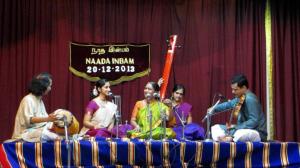Reflecting on her experiences as a musician, Preetha Narayanan encourages bringing the South Asian principle of “Rasa” to our practices as artists, teachers and collaborators. Preetha is a violinist, collaborative composer and doctoral candidate at the Guildhall School. Please add your comments in the “Leave a Reply” box below.
Illuminating Rasa
Finding meaning and purpose in the human experience has been the quest of mankind for hundreds and thousands of years. Whether through the lens of philosophy, psychology, sociology, or anthropology, we are constantly trying to find the right words to capture what we feel, think, believe, and value. Art and music are means to more intuitive modes of expression, connecting body and mind and eliciting an experience that is embodied. This notion of embodied meaning resonates with the Rasa Theory of Aesthetics, an ancient South Asian philosophy that emerged out of India and provides a framework to examine the intention in creation, the embodiment of the divine in performance, communication and transfer of emotions, or perhaps in other words the senses, perception, and deep listening shared between creator, performer, and spectator. A recent visit to Chennai, South India during the December Music and Dance season brought me in close proximity with Rasa, which serves as the foundation for the teaching and performance of all Indian performing arts.
The literal translation of Rasa stems from the root ras, ‘to taste’. Before finding its way into the arts, it was often used in ancient medicinal treatises and the Vedic scriptures to mean ‘taste,’ and ‘flavor,’ and ‘essence.’ First appearing in the aesthetic context in Bharatha’s Natyashastra, a compendium of dramaturgy, Rasa in its simplest understanding represents the nine dominant emotional states: love, laughter, sorrow, anger, heroism, fear, disgust, wonder, and peace. These nine emotions are portrayed in theater, and the performer is essentially the vehicle of Rasa. In its application in Indian Classical music, the instrumentalist strives to convey the Rasa, or principle emotion, to the minds of his listeners purely through the sound. The listener is able to feel and receive the meaning and the intention of the music in the listening through emotional rather than intellectual understanding.
Rasic performance “is not something that happens in front of the spectator, a vision for the eyes, but ‘in the gut,’ an experience that takes place inside the body specifically engaging the Enteric Nervous System (Schechner, 2001: 35). The basis of many Asian practices acknowledge that the gut is “the centre/source of readiness, balance, and reception, the place where action and meditation originate and are centered”(2001:38). The body itself becomes the site of knowing. The knowledge comes from within, from a place that is felt and understood intuitively rather than explicit and definable. Hidden and inexplicable, Rasa lies beyond what the naked eye can see, unlocking the tacit dimension of artistic experience.
Rasa also serves as a phenomenological approach to musical affect and meaning. Martin Clayton, in ’Introduction: towards a theory of musical meaning (in India and elsewhere)(2001)’, suggests:
- It focuses on the primacy of communication between performer and listener, emphasizing the role of the receiver and the importance of empathy or sensitivity
- It suggests an experience flowing and dynamic, rather than a solid, static entity
- It resists the linkage of affect to structure; the work of art is evaluated on its ability to evoke aesthetic response in the listener/receiver in the experience (Clayton, 2001,13)
Meaning in musical experience, taking this description into account, arises from the creative act and process rather than from the object alone. Rather than being a fixed form, music is a flow of the harmonies, the melodies, and rhythm in which temporality and impermanence are inherent. Rasa lends itself to the flow of moment to moment.
After my recent travels, I am even more convinced that all dimensions of artistic practice, teaching, performing, and collaboration, should bring Rasa to the core. Rasa is considerate of the lived and embodied creative process, from the very conception in the mind of the artist to its perception in the heart of the receiver. With Rasic awareness, we allow the gut and brain, the body and mind to engage fully in the emotional communication between performer and audience. This opens a door to the wholeness of experience.
Keywords: Rasa, Embodiment, Tacit Dimension
References:
Clayton, M. (2001) ’Introduction: towards a theory of musical meaning (in India and elsewhere)’, British Journal of Ethnomusicology, vol. 10, no. 1, pp. 1-17.
Schechner, R. (2001) ‘Rasaesthetics’, The Drama Review vol. 45, no. 3, September, pp. 27–50.




